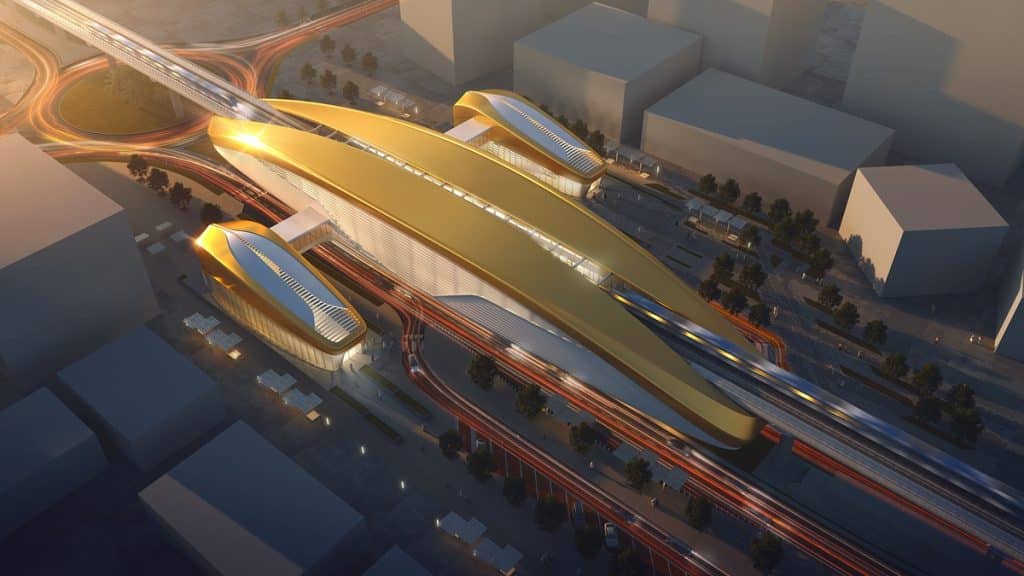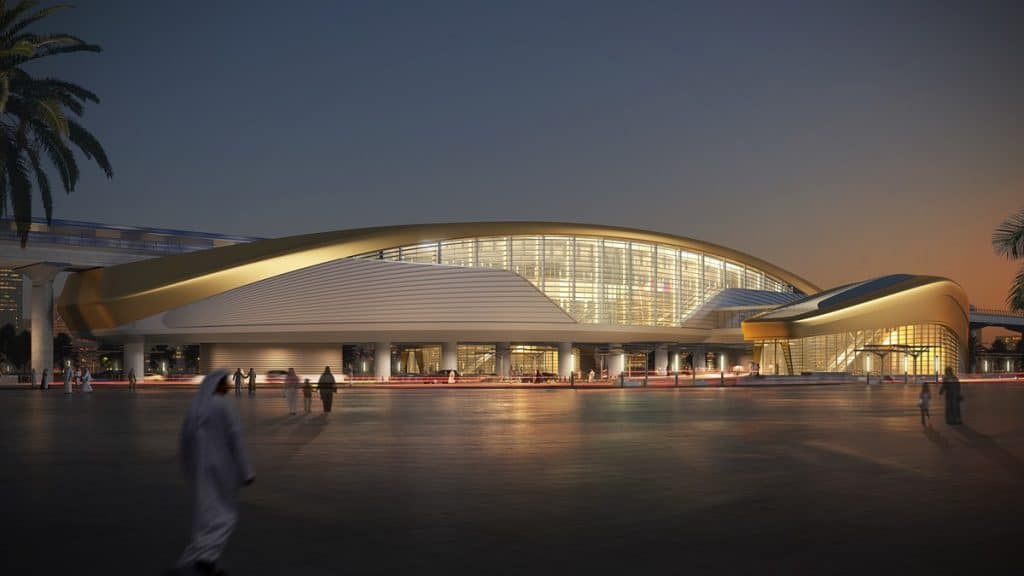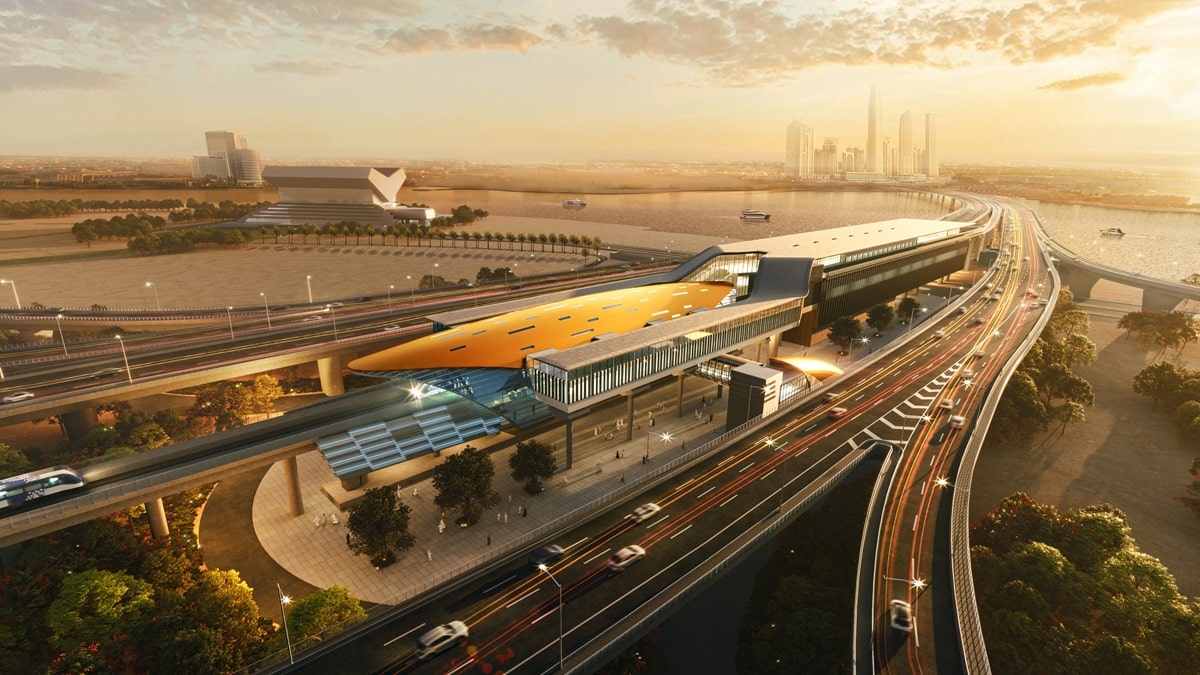Dubai Metro Blue Line has been officially approved and will open in 2029.
Sheikh Mohammed bin Rashid Al Maktoum, Vice President, Prime Minister of the UAE, and Ruler of Dubai announced the largest public transport project in the city, saying it will cost AED18bn ($4.9bn) to complete and will help transport billions of passengers around the city.
The 30km line will feature 14 stations and the first train crossing over the Dubai Creek.
Dubai Metro Blue Line approved
In a message on social media, Sheikh Mohammed said: “The Blue Line Route of the Dubai Metro, with a length of 30km – half of which is underground, at depths of up to 70m and at a cost of AED18bn – covers areas with a population of up to a million people. Such as Marsa, Dubai Creek, Festival City, International City, Al Rashidiya, Al Warqa, Mirdif, and urban areas such as Silicon Oasis, Academic City, and others.
“The new line will transport 320,000 new passengers daily”.
“It will continue to serve billions of people in the coming decades”.
The project will be developed in stages:
- 2023: Tender launch
- 2024: Awarding the project
- 2025: Start of tunnel drilling
- 2028: Trial operation
- 2029: Official operation
Sheikh Mohammed underscored that investments in infrastructure projects align with Dubai’s strategy for comprehensive city development, focusing on meeting present needs while preparing for the future.
He said: “Remarkable achievements don’t happen by chance; rather, they result from deliberate planning, creative thinking and a commitment to attaining the highest levels of leadership.
“The true measure of achievement lies in its positive impact on society. We strive for the best for our community, sparing no effort to achieve it at the highest standards”.
During a ceremony held at Dubai Creek Harbour, Sheikh Maktoum bin Mohammed bin Rashid Al Maktoum, First Deputy Ruler of Dubai and Deputy Prime Minister and Minister of Finance of the UAE launched the Dubai Metro Blue Line project.
Sheikh Maktoum said that Dubai remains committed to implementing world-class projects that not only enhance the city’s global standing but also reaffirm its leadership in developing high-level infrastructure that aligns with the emirate’s sustainable development goals.
The Blue Line represents a significant advancement as the first metro route crossing Dubai Creek through a 1.3km viaduct.
The Blue Line will span a total length of 30 km, with 15.5km running underground and 14.5km above ground.
With its 14 stations, including key interchange points like the Creek Station on the Green Line, Centrepoint Station on the Red Line, and Dubai International City Station 1, along with the iconic station at Dubai Creek Harbour, the Blue Line is set to be a pivotal element in the ongoing development of the city’s transportation network.

The new line is a key integration point between the Red and Green Lines of Dubai Metro.
It plays a significant role in realising the objectives of the Dubai Economic Agenda (D33) and Dubai 2040 Urban Master Plan aimed at transforming Dubai into the world’s best city to live in by offering sustainable and soft mass transit solutions.
These solutions are designed to facilitate the mobility of both residents and visitors, promoting well-being and enhancing Dubai’s global competitiveness as a leading destination for hosting international events.
Additionally, they align with the aspirations of the Dubai 2040 Urban Master Plan, which aims to create a “20-minute city”.
This innovative concept ensures that more than 80 per cent of essential services are within a 20-minute travel time for residents, fostering a Transit-Oriented Development (TOD) approach.
The Blue Line will offer a direct connection between Dubai International Airport and nine key areas along the line, namely:
- Mirdif
- Al Warqa
- International City 1
- International City 2
- Dubai Silicon Oasis
- Academic City
- Ras Al Khor Industrial Area
- Dubai Creek Harbour
- Dubai Festival City
The travel time between these destinations is anticipated to range from 10 to 25 minutes.
The Blue Line consists of nine elevated stations and five underground stations.
By 2030, the Blue Line is anticipated to serve approximately 200,000 passengers daily, with this figure expected to increase to 320,000 passengers daily by 2040.
The line is designed to handle an estimated capacity of about 56,000 passengers per hour in both directions at a service interval of about 1.5 minutes.
Sheikh Maktoum viewed models of the designs for both the upper and tunnel sections of the Blue Line stations.
He then marked the location on a large model depicting the project’s service areas, which also highlighted the position of the iconic station in the Dubai Creek Harbour.
This station embodies an innovative design that reflects the vision of the new Dubai. This design seamlessly integrates with the urban style of the surrounding modern residential and commercial towers.

Spanning 8,800 sq m, the station is engineered to accommodate approximately 160,000 passengers daily, with a projected increase to around 70,000 passengers daily by 2040.
Dubai Metro Blue Line represents the fifth strategic project in public transportation, joining the ranks of the existing Red and Green Lines of the Dubai Metro, Dubai Tram and Dubai Metro Route 2020.
It is one of the largest strategic projects in the transportation sector for the upcoming phase.
Upon the completion of the Blue Line, Dubai’s total railway network will extend from 101 km to 131 km.
This includes 120 km for the Dubai Metro and 11 km for Dubai Tram. The number of metro and tram stations will increase from 64 to 78, encompassing 67 stations for the Dubai Metro and 11 for the Dubai Tram.
Additionally, the fleet will expand from 140 to 168 trains, including 157 for the Dubai Metro and 11 for the Dubai Tram.
The Dubai Metro Blue Line links the Green Line at Creek Station with the Red Line at Centrepoint Station, catering to residential, academic areas and developmental projects.
The line will also serve one of the urban centres highlighted in the Dubai 2040 Urban Master Plan, namely the Dubai Silicon Oasis Centre, a knowledge and innovation international hub playing a crucial role in advancing the knowledge and technology economy sector and attracting talented and innovative individuals.
Mattar Al Tayer, Director-General and Chairman of the Board of Executive Directors of the Roads and Transport Authority (RTA) said: “Dubai Metro Blue Line comprises two main routes.
“The first route begins at the Creek Interchange Station on the Green Line, located in Al Jaddaf. It then passes through Dubai Festival City, Dubai Creek Harbour and Ras Al Khor, before reaching Dubai International City 1, which has an interchange station.
“The route continues towards Dubai International City 2 and 3, extending to Dubai Silicon Oasis and up to the Academic City. This section spans 21 km and features 10 stations.
“The second route of the Blue Line starts from Centrepoint Interchange Station on the Red Line in Al Rashidiya. It passes through Mirdif and Al Warqaa, concluding at the Dubai International City 1 Interchange Station.
“This route measures 9km in length and includes four stations. The project also includes the construction of a metro depot at Al Ruwayyah 3.”
“The Dubai Metro Blue Line stands out with several notable features, including an iconic station at Dubai Creek Harbour featuring distinctive architectural design.
“This landmark station will be crafted by the globally renowned firm Skidmore, Owings and Merrill (SOM), one of the largest architectural offices worldwide. SOM is renowned for designing iconic structures such as the Burj Khalifa, the Denver Union Railroad Station in Colorado and the Sears Tower in Chicago.
“Additionally, the Blue Line boasts the largest underground interchange station within the metro network, covering an expansive area of 44,000 square meters, designed to accommodate approximately 350,000 passengers daily.
“Notably, the Blue Line sets a precedent as the first transport project of its kind to adhere to green building regulations and specifications, achieving platinum category status.”

Al Tayer explained that the Dubai Metro Blue Line was meticulously planned with sustainability in mind, ensuring it connects various densely populated areas and projects.
By 2040, it is anticipated to serve regions with a combined population of around one million individuals.
Key areas served by the Blue Line include Dubai Creek Harbour and Dubai Festival City, noted for their immense development potential, as well as Dubai International City, home to Dragon Mart and large residential complexes visited by over 200,000 residents and visitors., he noted.
The Blue Line also serves residential neighbourhoods like Al Rashidiya, Al Warqa, and Mirdif.
It also extends to Dubai Silicon Oasis, recognised as one of Dubai 2040 Urban Master Plan’s Urban Centres, and the Academic City, which is projected to accommodate over 50,000 university students by 2029, Al Tayer added.
Initial studies by RTA indicated that infrastructure investment is a key driver of economic growth in cities worldwide.
The Dubai Metro Blue Line project aligns with the objectives of the Dubai Economic Agenda, D33, offering economic, social and environmental returns.
By 2040, the project is projected to yield a benefit-cost ratio of 2.60 (AED2.60 in benefits for every AED1 spent).
The total anticipated benefits exceed AED56.5bn ($15.4bn) by 2040. These benefits include substantial savings in time and fuel, reduced accident-related fatalities and lower carbon emissions.
The Blue Line is also expected to decrease traffic congestion on its served routes by 20 per cent and appreciate the value of land and properties near stations by up to 25 per cent.
The Blue Line also provides a direct connection between Dubai International Airport and nine key areas situated along its route.
It connects with the fifth urban centre, Dubai Silicon Oasis Centre, ensuring that all major urban centres in Dubai are seamlessly connected by metro lines.
The endorsement of the Dubai Metro Blue Line signifies a major milestone, building upon the huge success Dubai Metro has achieved since its inauguration in 2009.
The Metro has emerged as the backbone of Dubai’s transportation network, becoming the preferred mode of travel for both residents and visitors. It represents nearly 60 per cent of the total usage across all public transportation modes in Dubai, which include buses, the Dubai Tram, and marine transport means.
Up to last October, Dubai Metro has transported 2.2bn passengers since its inauguration and has averaged over 685,000 passengers daily in 2023.
The Dubai Metro has also recorded great success in upholding the highest international safety standards and operational efficiency, boasting a 99.7 per cent punctuality.
Dubai Metro maintains its position as the world’s longest driverless metro network, with a current total length of 90km.
This network includes around 52km dedicated to the Red Line, 23km for the Green Line, and 15km for Route 2020.
The network comprises 53 stations, with 29 on the Red Line, 18 on the Green Line, and six on Route 2020.
Additionally, the fleet consists of 129 trains. The facilities and services offered at the Dubai Metro stations are recognised as some of the best globally.






